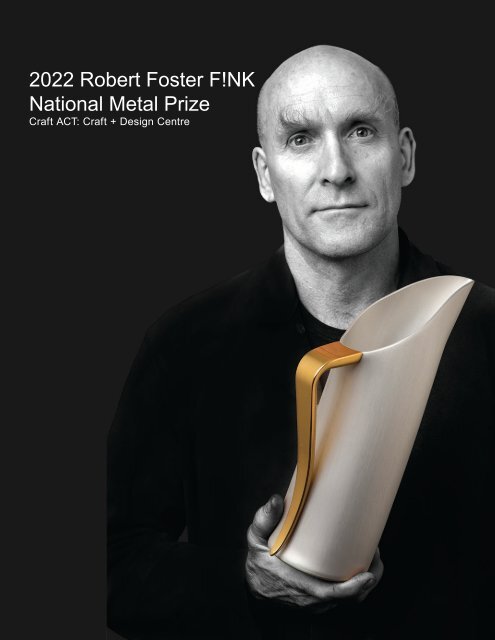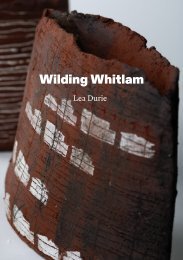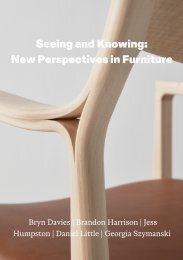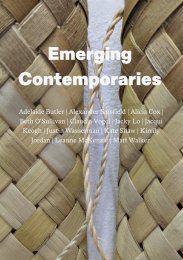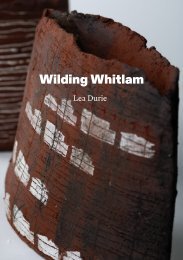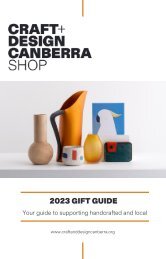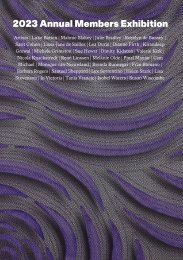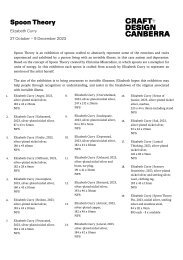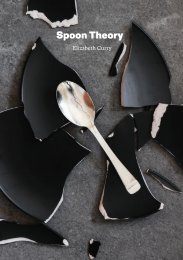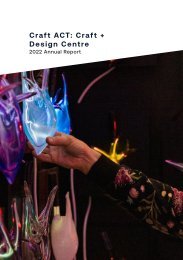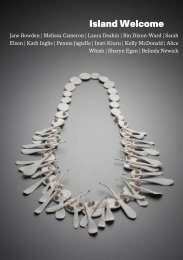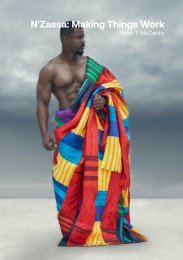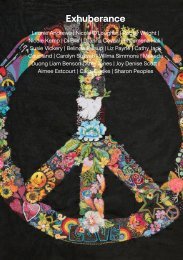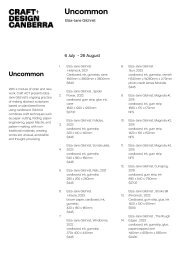2022 Robert Foster F!NK National Metal Prize
You also want an ePaper? Increase the reach of your titles
YUMPU automatically turns print PDFs into web optimized ePapers that Google loves.
<strong>2022</strong> <strong>Robert</strong> <strong>Foster</strong> F!<strong>NK</strong><br />
<strong>National</strong> <strong>Metal</strong> <strong>Prize</strong><br />
Craft ACT: Craft + Design Centre
Craft ACT: Craft + Design Centre is partial supported by the ACT<br />
Government, the Visual Arts and Craft Strategy – an initiative<br />
of the Australian State and Territory Governments, and the<br />
Australia Council for the Arts – the Australian Government’s arts<br />
funding and advisory body.<br />
Craft ACT: Craft + Design Centre acknowledges the<br />
Ngunnawal people as the traditional custodians of the<br />
ACT and surrounding areas. We honour and respect<br />
their ongoing cultural and spiritual connections to this<br />
country and the contribution they make to the life of this<br />
city and this region. We aim to respect cultural heritage,<br />
customs and beliefs of all Indigenous people.<br />
Craft ACT: Craft + Design Centre<br />
Tues–Fri 10am–5pm<br />
Saturdays 12–4pm<br />
Level 1, North Building, 180 London Circuit,<br />
Canberra ACT Australia<br />
+61 2 6262 9333<br />
www.craftact.org.au<br />
Cover image: Portrait of <strong>Robert</strong> <strong>Foster</strong>. Photo by Damian McDonald.
<strong>2022</strong> <strong>Robert</strong> <strong>Foster</strong> F!<strong>NK</strong><br />
<strong>National</strong> <strong>Metal</strong> <strong>Prize</strong><br />
Alison Jackson | Bic Tieu | Gretal Ferguson | Johannes Kuhnen |<br />
Jonathon Zalakos | Kirsten Haydon | Larah Nott | Lindy McSwan |<br />
Oliver Smith | Sean Booth<br />
Craft ACT: Craft + Design Centre<br />
27 October - 10 December <strong>2022</strong>
Image: Portrait of <strong>Robert</strong> <strong>Foster</strong> with Ossolites, 2010. Photo by Eddison Photographic Studio.
<strong>2022</strong> <strong>Robert</strong> <strong>Foster</strong> F!<strong>NK</strong> <strong>National</strong> <strong>Metal</strong> <strong>Prize</strong><br />
Craft ACT is honoured to present the new<br />
<strong>Robert</strong> <strong>Foster</strong> F!<strong>NK</strong> national metal prize,<br />
supported by the Tall Foundation and F!<strong>NK</strong> +<br />
Co Director, Gretel Harrison, and Craft ACT:<br />
Craft + Design Centre.<br />
The award will celebrate outstanding work<br />
in the field of contemporary metal working<br />
by designers and craftspeople - both<br />
established and emerging. In recognition of<br />
the value of high-quality craft making skills,<br />
good design and innovation ten artists will<br />
be selected and have their work exhibited in<br />
the popular DESIGN Canberra Festival. From<br />
the finalists, three makers, representing an<br />
established artist, an emerging artist, and<br />
an acquisition, will be selected and awarded<br />
generous cash prizes.<br />
This program is generously supported by the<br />
Tall Foundation, F!<strong>NK</strong> + Co., and Craft ACT:<br />
Craft + Design Centre.<br />
Image: <strong>Robert</strong> <strong>Foster</strong>, Yes Sir Teapot, 2007. Photo Courtesy of F!<strong>NK</strong> + Co.
Image: <strong>Robert</strong> <strong>Foster</strong>, Squashed Vessels. Photo Courtesy of F!<strong>NK</strong> + Co.
Gretel Harrison | Director F!<strong>NK</strong> Designs<br />
<strong>Robert</strong> <strong>Foster</strong> (1962-2016) had a deep love for<br />
metal and exploring its endless possibilities<br />
and was prolific in his career spanning over 30<br />
years working from artistic tea pots, functional<br />
hollowware, furniture, lighting, jewellery and<br />
sculptural installations. <strong>Robert</strong> had a deep appreciation<br />
and understanding of metal and was<br />
able to manipulate it in numerous ways, creating<br />
amazing, organic shapes many would not<br />
normally associate with the material.<br />
<strong>Robert</strong> invited many emerging makers to work<br />
with him and collaborated with numerous<br />
artists and designers with metal as their focus.<br />
He was generous in taking on mentorships and<br />
internships and helped shape the development<br />
of the careers of many Australian artists and designers.<br />
He would give lunch time classes at the<br />
primary school where his daughters Ineska and<br />
Mischa attended and the students would line<br />
up every year to get into his classes. They were<br />
attracted to him like he was a rock star! He was<br />
committed to teaching and embracing the possibilities<br />
of metal as it was his religion and his<br />
magnetic personality (that’s a metal joke!) made<br />
it impossible not to be excited about metal.<br />
From the mid-1980s <strong>Robert</strong> became internationally<br />
recognised for his expressive yet functional<br />
hand-made forms. He founded F!<strong>NK</strong> +<br />
Co in 1993 with the aim of creating a design<br />
and manufacturing business that would support<br />
and generate opportunities for Australian<br />
designer-makers. Joined by Gretel Harrison in<br />
1995, together they built F!<strong>NK</strong> + Co. into the<br />
business it is today – a much loved and respected<br />
Australian design company with an international<br />
reputation for producing world-class<br />
tableware, hollowware, jewellery and lighting.<br />
Be it the iconic F!<strong>NK</strong> Water Jug, the squashed<br />
Storage Vessels, the graceful Coolamon Platters,<br />
the Ned Kelly-esque Wine Chiller or the subtle<br />
curves of the Beaker, every F!<strong>NK</strong> product melds<br />
refined craftsmanship with shapes and colours<br />
largely inspired by the Australian landscape –<br />
tropical corals and fish, endless blue skies and<br />
vast deserts. Today, F!<strong>NK</strong> + Co. is spearheaded<br />
by Gretel Harrison, who is not only the face of<br />
the company but who also leads a dynamic<br />
team of practitioners. The company has continued<br />
to go from strength to strength as Gretel<br />
and the F!<strong>NK</strong> staff builds on the legacy of <strong>Robert</strong><br />
<strong>Foster</strong>.<br />
<strong>Robert</strong> believed strongly in the value of working<br />
between art, design and manufacture,<br />
respecting both form and function, pushing<br />
material boundaries and creating innovative<br />
forming processes, always with an expression<br />
of optimism and recognising the importance<br />
sustainability and longevity. He will be remembered<br />
as an imaginative and resourceful designer,<br />
who also had the mind of an engineer<br />
who never let the words ‘not possible’ into his<br />
mindset.
Tragically, <strong>Robert</strong>’s life was taken from us in a<br />
car accident on 13 July 2016. Since this time, it<br />
has been Gretel’s focus to keep <strong>Robert</strong>’s legacy<br />
alive and to encourage others to invest in learning,<br />
experimenting and exploring the art of<br />
designing and making with metal. This is what<br />
he would have continued to do, if his life was<br />
not cut so short. At the time of his death he had<br />
numerous exciting plans and projects in front of<br />
him. Gretel wanted this prize and exhibition to<br />
not only celebrate the affection and admiration<br />
we all held for <strong>Robert</strong>, but to reflect his continuing<br />
influence and showcase the extraordinary<br />
talent and diversity of metal makers in Australia<br />
today, whilst also showing the breadth and<br />
depth of ways that metal can be formed.<br />
<strong>Robert</strong> was a long-term, respected and active<br />
member of Craft ACT. He became an Accredited<br />
Professional Member in 1993, so it seemed<br />
fitting to Gretel to collaborate with Craft ACT<br />
for this <strong>Metal</strong> <strong>Prize</strong> given their commitment<br />
to metal crafts and <strong>Robert</strong>’s great respect and<br />
admiration for the organization. The careers of<br />
all three of the <strong>Metal</strong> <strong>Prize</strong>’s judges have intertwined<br />
with <strong>Robert</strong>’s career and share his love<br />
for metal.<br />
As a journalist back in 1999, Ewan McEoin witnessed<br />
<strong>Robert</strong> explosive forming his vases out<br />
in a back paddock in Queanbeyan, instilling in<br />
him a love and respect for metal. He is now the<br />
Senior Curator of Contemporary Design and<br />
Architecture at <strong>National</strong> Gallery of Victoria.<br />
Brian Parkes and <strong>Robert</strong> crossed many paths<br />
starting when Brian was at the <strong>National</strong> Gallery<br />
of Australia in 1998, later at Object Gallery in<br />
Sydney and again as the Chief Executive Officer<br />
at The Jam Factory in Adelaide.<br />
Finally, this prize and exhibition would not be<br />
possible if it weren’t for the incredible generosity<br />
and support from Roger and Maxine Tall from<br />
the Tall Foundation. They have been incredibly<br />
supportive of the Canberra arts and craft community<br />
at large and have pledged their continuing<br />
support in the future so that this significant<br />
prize and exhibition can continue in the years<br />
ahead.<br />
Rohan Nicol collaborated with <strong>Robert</strong> back<br />
in 1998 on the FI<strong>NK</strong> Bracelet when he was an<br />
emerging metalsmith. They continued to be<br />
close associates during Rohan’s Time as the<br />
Head of the <strong>Metal</strong> Working Department at the<br />
Australian <strong>National</strong> University. Rohan is now the<br />
Associate Head of School, Creative Arts and Media,<br />
Associate Professor of Fine Art, University of<br />
Tasmania.
Alison Jackson | Two Vessels Converse | <strong>2022</strong><br />
The vessel as a concept can be viewed with<br />
many perspectives both in a literal practical<br />
sense and as an imagined form of containment.<br />
I like to use the idea of the vessel to<br />
explore form, function, anthropism but primarily<br />
the craft of silversmithing.<br />
Raising is the process of forming vessels<br />
from a single sheet of copper, an age old<br />
traditional silversmithing technique where the<br />
sheet metal is skilfully hammered in rounds on<br />
specialised steel forms. What can seem like<br />
a simple process with rudimentary tools is in<br />
fact a nuanced and skilled technique that is<br />
a dying craft. Each vessel has had thousands<br />
of hammer strikes applied to manipulate what<br />
was once a uniform flat sheet into a three-dimensional<br />
vessel form.<br />
My process is a conversation between materials,<br />
ideas and forms. It is often one of repetition,<br />
heat, hammer, heat, hammer. Heated<br />
to soften and hammered to form. It is both<br />
rhythmic and mediative, my technique is<br />
about allowing the vessel to emerge rather<br />
than having a rigid idea of the final form. I<br />
think of it as the vessel emerging out of the<br />
material and out my thoughts, emotions and<br />
instinct. Each hammer blow moves it closer<br />
to a resolved form but also an individuality, it<br />
asserts itself and I start to think of them as<br />
characters. I often make pieces in pairs; this<br />
is because once the vessel leaves my hands<br />
the conversation between maker and vessel<br />
stops and a new dialog between the two<br />
vessels can begin.<br />
Photo: Tim Bean Photography
Bic Tieu | Flowers Between | <strong>2022</strong><br />
Using the format of a vase as a tangible<br />
metaphor to articulate in-betweenness. The<br />
vase as an ornamental container to display<br />
flowers changes by what is placed in the<br />
vessel. Similarly, this notion can be related to<br />
the framing of one’s identity living in-between<br />
and of cultures. This work is an exploration<br />
of myself as a Southeast Asian – Australian<br />
woman living between two cultures.<br />
The vessel design is a reflection of my<br />
experiences, my identity and the intercultural<br />
connections of life living between the eastern<br />
and western cultural spheres. I acknowledge<br />
the reality that exists ‘in-between’ and<br />
this work expresses a visual and material<br />
framework for my ongoing interest and<br />
belief in the value of the shared experience.<br />
Through living between these I revel<br />
The re-positioning and layered arrangement<br />
of the emblematic motif of deconstructed<br />
peonies are contextualized with Australian<br />
floral natives including fan flower, flannel<br />
flower, kangaroo paw, sturt desert pea,<br />
waratah and wattle. These motifs have a<br />
deep historical association with Asia and<br />
Australia connecting place, cultures and<br />
movement and metaphorically contribute to<br />
the layered meanings with identity.<br />
The design of the surface tension creates a<br />
dialogue for the Australian Southeast Asian<br />
diaspora, but more importantly, becomes<br />
instruments for articulating cultures that exist<br />
‘in-between’ cultural spaces.<br />
in the creative and metallurgical processes<br />
that inform my art and design practice.<br />
The surface design language is developed<br />
through a series of processes where I begin<br />
with collecting and rendering of flowers<br />
using digital graphic application. Through<br />
the illustration, I then take this into the laser<br />
cutting of components in which I use lost wax<br />
casting for metal alloys of silver and mixing<br />
of gold and copper into the composition.<br />
Numerous cast components are then further<br />
manipulated, cut and soldered to form the<br />
final sheet pattern. I then take this sheet to<br />
construct the final geometric form through a<br />
process of silver soldering to formulate the<br />
final form.<br />
The imagery on the vase draws on both<br />
eastern and western floral motifs endemic to<br />
my cultures to construct a visual language.
Photo: Tim Bean Photography
Gretel Ferguson | Out of Frame 1 | <strong>2022</strong><br />
After completing an Advanced Diploma of<br />
Jewellery and Object Design at Design Centre<br />
Enmore in Sydney, Gretal Ferguson moved to<br />
the UK to complete her Masters in Jewellery,<br />
Silversmithing, and Related Products at Birmingham<br />
City University’s School of Jewellery.<br />
On her return to Australia Ferguson moved to<br />
Adelaide and completed the 2 year Associate<br />
Programme at JamFactory where she now<br />
shares a private studio.<br />
Raised and formed to resemble the metal in<br />
its molten pre-worked state, the piece spills<br />
from an ornate gold frame, a placeholder for<br />
the artwork that once was. The laboriously<br />
hammered form is left blank and without<br />
function, suggesting the growing absence of<br />
skills required to rework it.<br />
Ferguson creates conceptual exhibition work<br />
using traditional craft skills in a sculptural setting,<br />
challenging the utilitarian traditions of her<br />
craft while honouring what came before. With<br />
the material process an integral part of her<br />
conceptual motivation, Ferguson embraces<br />
the arduous nature of silversmithing, using the<br />
hours of hammering to explore the work both<br />
aesthetically and conceptually, allowing it to<br />
unfold in a way it wouldn’t if the process was<br />
quick and less laborious.<br />
Out of Frame explores what happens when<br />
the intrinsic value of an objects’ material is<br />
seen to be more precious than the centuries<br />
of tradition involved in its creation. Throughout<br />
history metalwork has been melted down to<br />
create new objects or be hoarded in bank<br />
vaults, disregarding the original craftsperson’s<br />
hand, most only seeing value in the material<br />
itself. Yet as fewer artisans carry on these<br />
skills and traditions, we are in danger of losing<br />
the craft completely.<br />
This new work questions the future of silversmithing<br />
traditions. Though appearing to<br />
be silver the metal is actually plated copper,<br />
a result of artisans being priced out of their<br />
craft as their medium is a traded commodity.<br />
Photo: Tim Bean Photography
Johannes Kuhnen | Vessel <strong>2022</strong> | <strong>2022</strong><br />
Johannes Kuhnen is one of Australia’s most<br />
well-recognised gold and silversmiths.<br />
Coming from a well-developed European<br />
tradition, his contribution to Australian silver<br />
and jewellery, and hence Australian design,<br />
has been profound and has firmly established<br />
Kuhnen’s wok on an international platform.<br />
Johannes Kuhnen was the former head of<br />
the gold and silversmithing workshop at the<br />
Australian <strong>National</strong> University. Johannes has<br />
exhibited widely throughout Australia and<br />
overseas in both group and solo exhibitions.<br />
His work is held in the collections of the<br />
<strong>National</strong> Gallery of Australia, Canberra, the<br />
<strong>National</strong> Gallery of Victoria, Melbourne, the<br />
Powerhouse Museum, Sydney, the Art Gallery<br />
of Western Australia, Perth, Museum für<br />
Kunst und Gewerbe, Hamburg, Museum<br />
Boymans-van-Beunigen, Rotterdam,<br />
Staatliche Museen Preussischer Kulturbesitz,<br />
Kunstgewerbemuseum, Berlin, the Victoria<br />
and Albert Museum, London, the <strong>National</strong><br />
Museum of Scotland, Edinburgh, Die Neue<br />
Sammlung, the design museum at Pinakothek<br />
der Moderne, Munich.<br />
Johannes’ practice has remained at the<br />
forefront of innovation, in particular his<br />
pioneering use of anodised aluminium. A<br />
fascination with the colour options of the<br />
aluminium as well as titanium continue to<br />
provide inspiration for his work and has<br />
also inspired many others to explore such<br />
potential. Johannes’s current practice<br />
continues to capture his mastery and sense<br />
of understanding of what you can do with<br />
hard materials such as titanium, which<br />
currently takes a leading role in his objects<br />
and wearable art.
Photo: Tim Bean Photography
Jonathon Zalakos | Hydroformed Sake Set | <strong>2022</strong><br />
Jonathon Zalakos is an emerging artist and<br />
contemporary jeweller based in Canberra,<br />
Australia, on Ngunnawal and Ngambri land.<br />
He seeks to integrate traditional goldsmithing<br />
materials and techniques with contemporary<br />
practices and philosophical thought. His work<br />
takes the form of jewellery, interactive objects,<br />
digital media and installation. Jonathon is particularly<br />
interested in how meaning is co-produced<br />
through the processes of expression<br />
and perception. This drives exploration into<br />
the visual language of cultural phenomena<br />
including contemporary pop jewellery culture,<br />
online viral media and the two-way relationship<br />
between the human and manufactured<br />
worlds. These concepts are deconstructed<br />
and reassembled so as to consider the different<br />
worlds we occupy with our bodies and<br />
minds.<br />
My application for this prize is inspired by<br />
<strong>Robert</strong> <strong>Foster</strong>’s own pursuit of craft innovation<br />
and aesthetically streamlined design. For<br />
me, this means embracing curiosity, experimentation<br />
and a keen eye for finishing details.<br />
I explore hydroforming as a manufacturing<br />
technique - a method of ‘inflating’ closed<br />
metal vessels with pressurised water so as to<br />
create complex hollow forms. Typically this is<br />
done with tube in heavy dies to create repeatable<br />
and precise components: car exhaust<br />
pipes for example. I integrate classic silversmithing<br />
processes to create hollow forms<br />
that are then inflated like balloons, where the<br />
final shape is unpredictable and emergent.<br />
A tension between divergent properties of<br />
liquid are captured in the process as the jug<br />
and cups seem to be nearly bursting at the<br />
seams, yet remain completely functional for<br />
containing and gently pouring out sake.<br />
Photo: Tim Bean Photography
Kirsten Haydon | Ice Draw | <strong>2022</strong><br />
Kirsten Haydon investigates the potential<br />
of gold and silversmithing to communicate<br />
human experience and connections with<br />
the environment. Kirsten Haydon completed<br />
a PhD in 2009 and has been teaching at<br />
the School of Fine Art, RMIT University in<br />
Melbourne since 2002. Kirsten travelled to<br />
Antarctica as a New Zealand Antarctic Arts<br />
Fellow in 2005. Her art practice, crafts and<br />
explores connections and observations of<br />
the environment through concepts of historic<br />
photography and micromosaics. Site and<br />
archival studies inform works which aim to<br />
engage the act of remembering and the<br />
fragile futures of ice by assembling and<br />
drawing on metal and enamel surfaces.<br />
Ice has a salient condition in the preserving<br />
and storing of atmospheric knowledge<br />
and histories within its structure. Through<br />
precipitation, ice, and its inclusions both<br />
the micro and macro are created from the<br />
surrounding environment and atmosphere,<br />
this provides details about the moment the<br />
ice was formed.<br />
Glacial ice is considered mono-mineralic rock<br />
and is the metamorphism of thousands of<br />
individual snowflakes into crystals of glacier<br />
ice. Over ninety percent of the earth’s glaciers<br />
are in Antarctica, a mass of ice forms, all<br />
these landscapes are locked, holding water<br />
droplets in freezing conditions. As global<br />
temperatures rise these landscapes begin to<br />
fall away, ice once stored is then released as<br />
individual water droplets dispersing into the<br />
ocean and evaporating into the clouds high<br />
above.<br />
Ice Draw is a response to two experiences<br />
of fieldwork. First was the immense and<br />
macro experience of standing beneath the<br />
gigantic ice wall known as the Barne Glacier<br />
on the Ross Ice Shelf in Antarctica. The<br />
second, reflecting on the micro investigations<br />
undertaken by international climate scientists<br />
in 2012 at the GNS Ice Core Research<br />
Laboratory in Wellington. Standing and<br />
seeing for myself the handling of precious<br />
individual ice cores being manually cut and<br />
sectioned before being melted sequentially<br />
in a controlled environment. This process led<br />
to the collection of atmospheric data and<br />
individual water droplets to investigate the<br />
stability of the Ross Ice Shelf.<br />
Ice draw is created to depict ice landscapes<br />
and connect with concept of archiving,<br />
preservation and holding. Draw has many<br />
meanings, and in this work, draw connects<br />
with the notion that ‘to draw’ or ‘draw up’<br />
takes or obtains liquid from a container.<br />
The work Ice draw references the drawer<br />
as a container not a static archival drawer<br />
but a porous work comprised of parts and<br />
elements.<br />
Perforated, hand drawn and etched, the<br />
heat blackened Layered steel containers are<br />
transitional and changing. The containers are<br />
scaffolded fragments that depict sections<br />
of the Barne Glacier as it was in 2004.<br />
The enamelled image is reflective when<br />
experienced, as the micro glass reflector<br />
beads produce retro-reflection, a type of<br />
reflection that redirects incident light from the<br />
surface back to the source. The enamelled<br />
microspheres represent the countless<br />
individual snowflakes or drops of water that<br />
combine to form the Barne Glacier. The<br />
boundaries of the transparent spheres<br />
reference the unique precious souvenir<br />
micromosaics depictions of significant<br />
landscapes.
Photo: Tim Bean Photography
Larah Nott | Pleat One | <strong>2022</strong><br />
Pleat: a double or multiple fold in a garment or<br />
other item made of cloth<br />
My practice is always evolving. Working with<br />
geometric and architecture inspired shapes<br />
I produce large wearable pieces in titanium<br />
and mild steel. Another part of my practice<br />
is vessels. I enjoy working at a larger scale,<br />
pushing materials and working with shadow<br />
and depth. Previous works have explored<br />
light and dark, where light falls and shadow<br />
prevails. The flow of line is important to the<br />
scale and materials of the work.<br />
This new work, Pleat, is a further exploration<br />
in to materials and form. During research<br />
for this piece, I wanted to expand upon the<br />
fold concept and found pleating the material<br />
added a vibrancy and movement to the work.<br />
The eye wants to travel around and explore<br />
the work. I am asking a lot of the materials,<br />
designing with industry and using a combination<br />
of modern and traditional techniques. My<br />
practice is always a balance of machine and<br />
handmade, a joining of traditional and new<br />
ways of working with materials.<br />
Photo: Tim Bean Photography
Lindy McSwan | To Cart Carry Convey | <strong>2022</strong><br />
The mild steel vessel, often in combination<br />
with other materials, has been the foundation<br />
of my practice since my undergraduate<br />
studies in gold and silversmithing. More<br />
recently I have developed a deeper material<br />
focus looking to material properties, qualities,<br />
and transformation in the life cycle of<br />
steel. This begins with iron ore, the primary<br />
material essential to iron and steelmaking.<br />
Experimenting with different methods of using<br />
iron ore, the most effective to date has been<br />
grinding the material by hand and blending<br />
it with vitreous enamel, then applying to the<br />
surface of these vessels before firing in a kiln.<br />
In this body of work the vessel forms<br />
respond to my fieldtrips to the Whyalla and<br />
Port Kembla steelworks. The steelworks are<br />
effectively an extensive system of vessels<br />
and structures, mostly made of steel, that<br />
transport, store, and process material in the<br />
production of iron and steel. Kilometres of rail<br />
networks, carriages, monumental industrial<br />
vessels, conveyors, furnaces, cavernous,<br />
corrugated steel sheds and forming systems,<br />
empty, fill, move, transform, and contain vast<br />
quantities of material in a continuous process<br />
of steelmaking. The title given to this work<br />
reflects on this experience as well as notions<br />
of containment embodied in the vessel more<br />
broadly.
Photo: Tim Bean Photography
Oliver Smith | Naturally Wild | <strong>2022</strong><br />
I propose to create a metallic sculpture referencing<br />
antlers from which hang a series of<br />
metal utensils. This work will be an exploration<br />
of the hot-forging process. This hammer<br />
forming technique will be used to produce<br />
sculptural and functional objects that support<br />
the activities of cooking, serving and eating.<br />
The title and source of inspiration is Cernunnos<br />
- The Lord of Wild Things.<br />
The major elements in this work will consist of<br />
two sculptural forms, hot-forged in metal, that<br />
reference the horns of Cernunnos, the archaic<br />
divinity that watches over the wilderness. The<br />
antlers will branch upwards and outwards,<br />
visually suggestive of growth and movement.<br />
They will be three-dimensional flow charts,<br />
manifestations of energy transfer in the<br />
broader river of life or the movement of blood<br />
in an individual circulatory system.<br />
hot-forging process will imbue the objects<br />
with a gestural quality that will heighten the<br />
dynamism of the collection of forms. These<br />
purposeful utensils are in turn further enlivened<br />
through use, the daily rituals of food<br />
preparation and social eating becoming a<br />
homage to the source of the foodstuff itself.<br />
This proposal builds upon my established<br />
body of work exploring the realm of cutlery<br />
and the technique of hot-forging. This foundation<br />
will be extended through the larger<br />
scale antler inspired elements, resulting in<br />
purely sculptural outcomes. The work is intended<br />
to be a living altar to that which we<br />
owe benefaction, the turning of the seasons<br />
and nature’s many gifts. The antlers and utensils<br />
will be a salute to the craft of silversmithing<br />
and a celebration of the rich bounty of all<br />
that nourishes us.<br />
The metallic interpretation of the antlers will<br />
support a series of minor elements consisting<br />
of a series of knives, forks, spoons, serving<br />
spoons, ladles, scoops and tongs. The collection<br />
of hot-forged utensils will be designed<br />
for the preparation, cooking, serving and<br />
consumption of food. Each item will hook and<br />
hang from the pronged ends of the major<br />
forms, akin to a taxonomy of flora or fauna<br />
whose interconnectedness is made evident<br />
when viewed as a group. When at rest each<br />
utensil is an oblation, an offering made to a<br />
deity dedicated to the natural world.<br />
Advancing the aesthetic sensibility activated<br />
in the antlers, the design and material language<br />
of each utensil will reflect the requirements<br />
of function brought to life through the<br />
malleable and ductile properties of metal. The<br />
Photo: Tim Bean Photography
Sean Booth | Tranquillity|<br />
My intention is to bring together traditional<br />
and modern methods of working with metal,<br />
to produce a holloware object that combines<br />
my experience and training in hand forming<br />
techniques with digital technology and<br />
modern machining processes.<br />
Drawing inspiration from <strong>Robert</strong>‘s deep and<br />
unique understanding of metal forming and<br />
manipulation, my work employs traditional<br />
silversmithing techniques to generate<br />
a dynamic asymmetrical hand formed<br />
aluminium vessel. The hand formed vessel is<br />
the first phase of the process. I then digitise<br />
the form to allow me to engage with the work<br />
in the digital workspace. Utilising computer<br />
aided design software, I then design and<br />
program the processes that will transform<br />
the handmade surface. I use these powerful<br />
modern tools to program the intricate tool<br />
paths, manifesting this digital language onto<br />
the work’s surface and form.<br />
As a maker I feel that I have a foot in two<br />
camps, one the traditional handmade<br />
organic physical world and the other modern<br />
computer derived and control production that<br />
is accurate and defined. With this approach<br />
I blend traditional hand forming techniques<br />
and modern machining together to generate<br />
a unique and innovative work that progresses<br />
contemporary craft while acknowledging its<br />
heritage. This work embodies my 20 years of<br />
learning and commitment to development of<br />
skills across a variety of disciplines. Bringing<br />
together my hand forming, digital design and<br />
machining knowledge in one work.
Photo: Tim Bean Photography
Alison Jackson, Two Vessels Converse,<br />
<strong>2022</strong><br />
hand raised copper, patination<br />
110 x 110 mm (larger), 75 x 70 mm (smaller)<br />
$5,000<br />
Bic Tieu, Flowers Between, <strong>2022</strong><br />
Sterling silver and shakudo<br />
215 x 155 x 51 mm<br />
$5,000<br />
Gretel Ferguson, Out of Frame 1, <strong>2022</strong><br />
silver plated copper, frame<br />
260 x 330 x 80 mm<br />
$4,990<br />
Johannes Kuhnen, Vessel <strong>2022</strong>, <strong>2022</strong><br />
titanium, anodised aluminium, monel, stainless<br />
steel<br />
477 x 402 x 217 mm<br />
$40,000<br />
Oliver Smith, Naturally Wild, <strong>2022</strong><br />
316 stainless steel, monel, .900 silver, brass<br />
wall mount<br />
Knives $360 each, Forks $360 each, Spoons<br />
$400 each, Serving Blades $420 each, Slotted<br />
Serving Utensils $420 each, Serving<br />
Spoon & Ladle $900, Stand & Wall Mount<br />
$800
Jonathon Zalakos, Hydroformed Sake Set,<br />
<strong>2022</strong><br />
Powder coated copper<br />
200 x 80 x 80 mm (bottle), 70 x 70 x 70 mm<br />
(cups)<br />
$700<br />
Kirsten Haydon, Ice Draw, <strong>2022</strong><br />
Vitreous enamel, photo transfer, reflector<br />
beads, etched and heat blackened steel, inkstained<br />
Tasmanian oak, sterling silver<br />
430 x 630 x 250 mm<br />
$7,000<br />
Larah Nott, Pleat One, <strong>2022</strong><br />
mild steel, titanium, sterling silver, wax<br />
145 x 300 x 250 mm<br />
NFS<br />
Lindy McSwan, To Cart Carry Convey #1-5,<br />
2019<br />
mild steel, vitreous enamel, iron ore<br />
140 x 120 x 40 mm (#1), 210 x 70 x 60 mm<br />
(#2), 230 x 160 x 65 mm (#3), 130 x 68 x 60<br />
mm (#4), 85 x 80 x80 mm (#5)<br />
$1430 (#1), $1580 (#2), $1800 (#3), $1430<br />
(#4), $1210 (#5)<br />
Sean Booth, Alisterus, <strong>2022</strong><br />
Anodised aluminium, hand formed and CNC<br />
machined vessel<br />
90 x 80 x 195 mm<br />
$5940


